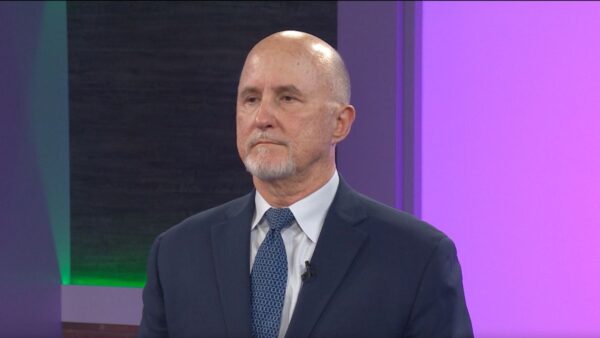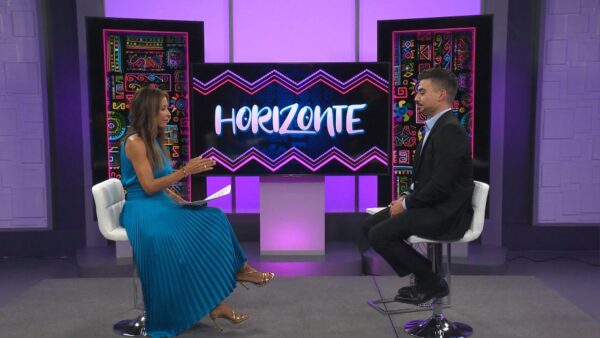Panfilo Contreras, executive director for the Arizona School Boards Association; Chuck Essigs, director of Governmental Relations for the Arizona Association of School Business Officials; and Ann-Eve Pederson from the Arizona Education Network discuss how budget cuts to K-12 education will impact schools and students.
José Cárdenas: Arizona lawmakers will cut the K-12 budget by $180 million next school year. What does this mean for your child's classroom? Here with me to talk about this is Panfilo Contreras, executive director for the Arizona school boards association, chuck Essigs, director of governmental relations for the Arizona association of school business officials, and Ann-eve Pederson of the Arizona education network. Thank you all for joining us on "Horizonte." Ann let's start with you, I think the other two organizations are fairly well known but yours is relatively new.
Ann-Eve Pederson: We are a parent-founded organization and we're non-partisan and non-profit grassroots group and what we do is we track the legislature and let people know how they're voting on education issues and we encourage education supporters to make sure they know who their legislators are and know whether they're voting for or against education funding issues and we were founded by a group of parents who were concerned about the cuts in 2009 and we've seen the continuation of those cuts. We're looking at $173 billion cut to K-12, community colleges and our university systems over the past three years and in the K-12 system, what we've seen in the children's classrooms are larger class sizes and schools shut in some of our school districts and libraries shuttered and the loss of arts and P.E. programs and loss of talented teachers leaving the profession because of the climate in Arizona that has become I think hostile to public education.
José Cárdenas: Now Panfilo, the governor budget, that she originally proposed was not as drastic in terms of cuts. Give us a sense what those numbers were and where we ended up with the budget deal she reached in the legislature.
Panfilo Contreras: I think the governor's first proposal was something in the neighborhood of $85 million cut to K-12 and ended up what it is and there are some other aspects of that.
José Cárdenas: What's it about now? You hear different figures. $180 million versus $133 million and -- who is right?
Chuck Essigs: They're probably both right depending on the assumptions you use, but they're significant cuts in either case.
Panfilo Contreras: And Panfilo, before we got on the air, you were making the point that in addition to these cuts there have been other revenue reductions that impacts education.
Panfilo Contreras: Yeah that's just the beginning. That's the state funding that comes into the local districts, there are other cuts. Sales tax is an example, because of the economy and proposition 301 funding has gone down considerably and Chuck can talk more specific about that. But local overrides, are also lost funding and many communities, many many communities, the layoffs as a result of cuts are also lost to the economy in those local communities.
José Cárdenas: Now Ann-Eve, you've talked about the impact in the classroom? They'll be bigger. But as Panfilo just mentioned, we're going to lose employees.
Chuck Essigs: We're going to lose employees and employees are going to lose their compensation, the classroom site fund which went into effect with the 6% increase in the -- the six cent increase in the sales taxes that's down, which is money that went to teacher salaries and performance pay and can't blame the legislature and governor for that. That's just the bad economy but that's on top of the other reductions that the districts are facing. Less money means less employees and less pay for employees.
José Cárdenas: And there's some things that school districts simply aren't in the position to cut because of other mandates from the federal government.
Chuck Essigs: Well for example, programs for disabled students are mandated by the federal government, the type of services you have to provide there's also a state mandate for that and you can't cut those programs without violating the law, which requires certain physical therapies, occupational therapy and special class programs authorize those students and a certain portion is off limits from cuts because of those things that are mandated.
José Cárdenas: And Panfilo - both of you, I'd like your thoughts on this point which many make, which is that there's a lot of fat in the K-12 system still, despite these cuts and the system should be able to absorb these cuts.
Panfilo Contreras: Well I think that's great rhetoric but it's absolutely false. If you look at the auditor general's reports over the last few years and they show very, very directly, as he example one the biggest myths is administrative cost, actually administrative cost in Arizona they're below the national average, well below the national average and as we get these cuts and they upset directly the teachers in the classroom, you'll have less money in the classroom just by the math rather than bloated administration as a lot of people would like to say. It's rhetoric. We're cutting down, we're past cutting to the bone. Class sizes will go up. I heard today there are kindergarten class was 30 kids in them without an aide. That's difficult. And then we have in this age of accountability, where teachers and principals and school districts are held real high accountability requirements, it's becoming more and more difficult. People are going to be leaving -- leaving the -- their careers. Because they're just so frustrated at not being able to do the job they had a commitment to do.
José Cárdenas: And Ann what about that criticism, too much money doesn't go into the classroom. It's been on administration?
Ann-Eve Pederson: You know, I think that's really just complete mythology and I think it's a rationalization that a lot of people use to justify defunding our schools. What we saw in the very beginning when these school cuts first started is that school districts doing everything they could to keep the cuts out the classrooms. So they took hits at reducing anything they could at an administrative level and what is happening now, there's nothing left to cut. I agree, we've gone past any cuts to discretional cutting we've -- cut to the bone, I think we're cutting into the heart of our educational institutions and when you talk about what is termed classroom funding, when the state auditor general's report comes out, it can be confusing to people, what they see money not spent in the classroom and they assume that that money is spent in the district offices. That money is actually spent on core employees like our counselors, school psychologists, people who are bus drivers, cafeteria workers, people we need for schools to function. They can't function without these positions - and just because they aren't physically in the classroom, they're not the true administrators that a lot of people think of. I think it's a myth and a very damaging myth because it allows people to continue rationalizing, very damaging and very deep cuts that are hurting our children Ann and I think -- in our country, we don't make our children sacrifice. Adults sacrifice during difficult economic times. This budget is making our children sacrifice and I don't think that's what the majority of Arizonans want. The majority of Arizonans voted overwhelmingly for prop 100. Which said we want money going into the schools. This legislature and governor violating the trust that the public put into them when we voted for prop 100. So -- anyway.
José Cárdenas: Chuck, what about the impact this may have on Arizona's competitive position amongst other states.
Chuck Essigs: We spend 25% below the national average. For every dollar that gets spent, on the average in other state, we're only spending 75 cents. So that makes it that much more difficult to cut. Now sometimes you have to put things into perspective. Without the governor working on the increase in the sales tax, we'd had another billion of cuts to make. There are some things people have done to mitigate those things. What was very revealing - just a few weeks ago Craig Barrett, the ex-person who ran Intel, basically said that if they were making that decision today, he wouldn't move Intel to Arizona based on the way we fund education. That should be a wakeup call for a lot of people.
José Cárdenas: Well Ann--I know that you've been critical though, despite the fact that you have Craig Barrette making the comment, the business community has not been out there fighting for education.
Ann-Eve Pederson: I think the business community needs to do a lot more than they've done to date and this directly affect affects our business climate in the state. As Craig Barrette said, we are not going to be able to recruit new businesses to stay here, we've also had Glenn Hammer from the chamber of comers say that he's been told by companies that you can have the best tax and regulatory system in the country but if you degrade your universities, we'll be sending you a postcard from Alabama. So the business community knows if we underfund and defunding education we're not going to be able to keep the good paying jobs that we have and we are not going to be able it recruit new ones yet they're silent on this issue. Our group sent a letter to the 60 CEOs that had contacted the senate and asked them to back down on the immigration legislation because it was bad for the state's tourism industries and we asked them to do the same for education and tell the senate not to move forward with the damaging cuts they've pushed and we've heard little back from the business community. Which was very disappointing and I think they're going to need to step up to the plate and do something big for education because it affects their bottom line.
José Cárdenas: And on that note, we'll have to end our discussion. I'm sure we'll have you all back to talk about this issue as it unfolds. Thank you very much for joining us.
Panfilo Contreras: Thank you.
Panfilo Contreras:Executive Director,Arizona School Boards Association;Chuck Essigs:Director of Governmental Relations, Arizona Association of School Business Officials;Ann-Eve Pederson:Arizona Education Network;




















